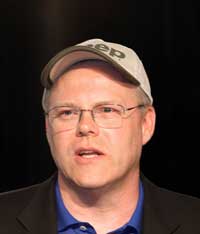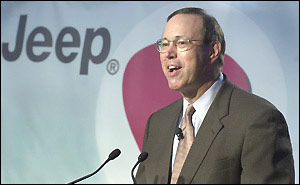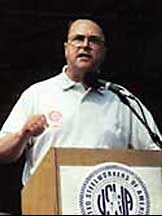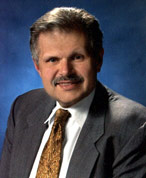LOOKING FOR A PREVIOUS STORY? CHECK THE
ARCHIVE.
Chrysler, Suppliers Joining in Innovative $2.1B Toledo Deal
by JACK LYNE, Site Selection Executive Editor of Interactive Publishing
 |
| The Chrysler deal ensures the future of 3,800 employees near the banks of Lake Eire in Toledo (pictured). |
TOLEDO, Ohio — Chrysler (www.chrysler.com) and three suppliers with non-U.S. roots are partnering in a groundbreaking US$2.1-billion project in Toledo, Ohio (www.rgp.org).
The project is unprecedented for a U.S. auto assembly plant. All four firms are building separate plants on the same site, and each will independently own and operate its building. In addition, some of Chrysler’s current workers will move over to become employees in the three new supplier plants.
The automaker is shouldering by far the project’s
biggest financial commitment. Its projected capital investment totals
$1.8 billion, Chrysler Group Chief Operating Officer Tom LaSorda explained
at the Aug. 4th announcement in Toledo.
Some $900 million of that amount will go to build a brand-new assembly plant to replace a local manufacturing landmark: the 90-year-old Jeep production operation known as Toledo Parkway. The new facility will consolidate Chrysler’s 3,800 workers who currently make the Jeep line in Toledo. The automaker will spend another $900 million to add new vehicles to the Toledo production line. Most of the rest of the company’s investment will go for new product development and, possibly, for the development of a park for additional suppliers.
The three suppliers selected thus far — Durr Industries North America, Hyundai Mobis and Kuka Flexible Production Systems — will collectively spend an estimated $300 million of their own funds to build separate body, chassis and paint plants adjacent to Chrysler’s plant. Currently, the Toledo Parkway facility does all Jeep body, chassis and paint work.
Conveyor belts will connect the four new plants.
Significantly, jobs as well as parts will be moving between the new facilities. Overall, the number of employees making the Jeep line will remain stable. But Chrysler’s total employment will actually shrink. When all four new facilities go into production in 2006, almost 20 percent of the 3,800 jobs at the site will shift from the automaker’s payroll to the three suppliers’.
“At the Chrysler Group, we love to defy conventional wisdom,” said LaSorda.
“By partnering in this way with suppliers for body shop, paint and chassis operations, Chrysler Group is able to optimize capital dollars for investment in future products,” he told the audience in Traverse City, Mich. “That’s capital spending flexibility. That’s reinvigorating our business model.”
And that model, some observers might add, could certainly use reinvigoration. Chrysler Group lost $637 million last year on $62 billion in sales.
The Ohio outsourcing could obviously strengthen the bottom line for the DaimlerChrysler (DC at www.daimlerchrysler.com) division. The suppliers’ $300-million investment is capital that Chrysler won’t have to spend. That savings “is enough to pay for one additional derivative product,” LaSorda said in Toledo.
If the outsourcing is a major success, industry analysts expect Chrysler to carbon-copy the Toledo model at some of its 13 other North American assembly plants. Almost all are located on non-greenfield sites in
urban areas.
“Today, 23 of our 24 major manufacturing facilities are still in urban locations and are still part of the economic lifeblood of their communities,” LaSorda noted at the project announcement. UAW Pact Paved Way But without the United Auto Workers’ (www.uaw.org) cooperation, the project almost certainly would’ve been part of another community’s lifeblood.
“This is a true collaborative partnership with the UAW,” said Frank Ewasyshyn, DC executive vice president of manufacturing.
“We had to look long and hard at what kind of innovative work practices would allow an investment like this to happen in an operation like Toledo — the oldest existing manufacturing facility in America,” he continued. “The UAW recognized that having suppliers based in our facility could open new opportunities. It just meant looking at it from a different direction.”
UAW Local 12 opened the door for Chrysler’s outsourcing late last year, when members approved a new eight-year labor agreement by a 3-to-1 margin.
That pact reflects the more flexible negotiating style that UAW has adopted. After long opposing a tiered pay system at a single production site, the union has conceded that different kinds of jobs require different pay.
The UAW did insist that the three supplier plants would be unionized, and Chrysler agreed. And employees in suppliers’ body and paint plants will earn the same $26-an-hour wage made on the Toledo assembly line. The UAW, however, agreed to lower wages in the outsourced chassis plant. Wages for industry suppliers that are unaffiliated with an automaker run about $15 to $18 an hour.
In addition, the UAW contract allows Chrysler to outsource non-core jobs (e.g. janitorial work, materials handling). Heretofore, those non-core employees were contractually guaranteed the same pay as assembly-line employees.
A key point in getting the UAW’s buy-in was Chrysler’s contractual commitment to invest an additional $1.2 billion in Toledo beyond the capital for the new assembly plant. That extra investment ensures the long-term future for the automaker’s Toledo operations.
“This project keeps approximately 3,800 jobs right here in Toledo, and it enables us to implement new ways to become competitive in a rapidly changing time for our industry,” UAW Regional Director Lloyd Mahaffey said at the project announcement.
The UAW’s agreement gives laid-off union members first crack at any additional jobs that current or future suppliers create.
Chrysler Group in May of 2003 cancelled its previously announced $1.6-billion plan to use a similar outsourcing arrangement to make a compact pickup truck in Windsor, Ontario. “We could not find a business case . . . [that] this could provide for reasonable return in the future to our bottom line,” Chrysler Group President Dieter Zetsche explained.
Federal and provincial officials’ indecisiveness over incentives was a factor trigger in the pullout, contended Canadian Auto Workers President Buzz Hargrove. Subsidies, he said, would’ve significantly bolstered Chrysler’s Ontario business case.
“It is just a horrible decision for Windsor, our union, the province of Ontario and Canada,” Hargrove said. “One more time, we have blown an incredible opportunity to stop the decline of Canada’s most important industry.” (For more details, see “Chrysler’s ‘End of the Day’ Not Kind to Windsor,” a SiteNet/IAMC Dispatch Special Report from the May 26, 2003, issue.)
In the Buckeye State, Chrysler and the three supplier companies will share in the Toledo project’s incentives, said officials with the Ohio Department of Development (ODOD www.odod.ohio.gov). The Buckeye State’s subsidies include $64.6 million in tax credits for job creation and retention, $44.7 million in loans and bond financing, and $7.6 million in grants.
“This decision shows great confidence in the quality work force here in northwest Ohio,” Gov. Bob Taft (R) said at the announcement. “We will have even more opportunities to showcase our great work force as additional jobs are added by local suppliers supporting the construction of the facility, supporting the manufacturing process, and providing vehicle parts.”
The project is unprecedented for a U.S. auto assembly plant. All four firms are building separate plants on the same site, and each will independently own and operate its building. In addition, some of Chrysler’s current workers will move over to become employees in the three new supplier plants.
 |
| By outsourcing body chassis and paint and operations, “Chrysler Group is able to optimize capital dollars for investment in future products,” said Chrysler Group COO Tom LaSorda (pictured at the project announcement). |
Some $900 million of that amount will go to build a brand-new assembly plant to replace a local manufacturing landmark: the 90-year-old Jeep production operation known as Toledo Parkway. The new facility will consolidate Chrysler’s 3,800 workers who currently make the Jeep line in Toledo. The automaker will spend another $900 million to add new vehicles to the Toledo production line. Most of the rest of the company’s investment will go for new product development and, possibly, for the development of a park for additional suppliers.
The three suppliers selected thus far — Durr Industries North America, Hyundai Mobis and Kuka Flexible Production Systems — will collectively spend an estimated $300 million of their own funds to build separate body, chassis and paint plants adjacent to Chrysler’s plant. Currently, the Toledo Parkway facility does all Jeep body, chassis and paint work.
Conveyor belts will connect the four new plants.
Significantly, jobs as well as parts will be moving between the new facilities. Overall, the number of employees making the Jeep line will remain stable. But Chrysler’s total employment will actually shrink. When all four new facilities go into production in 2006, almost 20 percent of the 3,800 jobs at the site will shift from the automaker’s payroll to the three suppliers’.
“At the Chrysler Group, we love to defy conventional wisdom,” said LaSorda.
‘Optimizing Capital Dollars’
LaSorda more fully defined Chrysler’s thinking the next day while speaking at Management Briefing Seminars, an annual auto industry conference.
“By partnering in this way with suppliers for body shop, paint and chassis operations, Chrysler Group is able to optimize capital dollars for investment in future products,” he told the audience in Traverse City, Mich. “That’s capital spending flexibility. That’s reinvigorating our business model.”
And that model, some observers might add, could certainly use reinvigoration. Chrysler Group lost $637 million last year on $62 billion in sales.
The Ohio outsourcing could obviously strengthen the bottom line for the DaimlerChrysler (DC at www.daimlerchrysler.com) division. The suppliers’ $300-million investment is capital that Chrysler won’t have to spend. That savings “is enough to pay for one additional derivative product,” LaSorda said in Toledo.
 |
| The four new facilities will replace the 90-year-old Jeep production operation known as Toledo Parkway, pictured above in a photo from the mid-1940s. |
If the outsourcing is a major success, industry analysts expect Chrysler to carbon-copy the Toledo model at some of its 13 other North American assembly plants. Almost all are located on non-greenfield sites in
urban areas.
“Today, 23 of our 24 major manufacturing facilities are still in urban locations and are still part of the economic lifeblood of their communities,” LaSorda noted at the project announcement. UAW Pact Paved Way But without the United Auto Workers’ (www.uaw.org) cooperation, the project almost certainly would’ve been part of another community’s lifeblood.
“This is a true collaborative partnership with the UAW,” said Frank Ewasyshyn, DC executive vice president of manufacturing.
“We had to look long and hard at what kind of innovative work practices would allow an investment like this to happen in an operation like Toledo — the oldest existing manufacturing facility in America,” he continued. “The UAW recognized that having suppliers based in our facility could open new opportunities. It just meant looking at it from a different direction.”
UAW Local 12 opened the door for Chrysler’s outsourcing late last year, when members approved a new eight-year labor agreement by a 3-to-1 margin.
That pact reflects the more flexible negotiating style that UAW has adopted. After long opposing a tiered pay system at a single production site, the union has conceded that different kinds of jobs require different pay.
 |
| Chrysler’s new deal “represents the great relationship between Ohio and Chrysler Group, and the commitment by both to keep Toledo the home of Jeep,” said Gov. Bob Taft (R). |
The UAW did insist that the three supplier plants would be unionized, and Chrysler agreed. And employees in suppliers’ body and paint plants will earn the same $26-an-hour wage made on the Toledo assembly line. The UAW, however, agreed to lower wages in the outsourced chassis plant. Wages for industry suppliers that are unaffiliated with an automaker run about $15 to $18 an hour.
In addition, the UAW contract allows Chrysler to outsource non-core jobs (e.g. janitorial work, materials handling). Heretofore, those non-core employees were contractually guaranteed the same pay as assembly-line employees.
A key point in getting the UAW’s buy-in was Chrysler’s contractual commitment to invest an additional $1.2 billion in Toledo beyond the capital for the new assembly plant. That extra investment ensures the long-term future for the automaker’s Toledo operations.
“This project keeps approximately 3,800 jobs right here in Toledo, and it enables us to implement new ways to become competitive in a rapidly changing time for our industry,” UAW Regional Director Lloyd Mahaffey said at the project announcement.
 |
| Chrysler’s partially outsourced project “enables us to implement new ways to become competitive in a rapidly changing time for our industry,” said UAW Regional Director Lloyd Mahaffey (pictured speaking at an earlier union rally). |
The UAW’s agreement gives laid-off union members first crack at any additional jobs that current or future suppliers create.
Company Pulled Plug on
Similar Plan for Canadian Site
Ohio’s almost $117 million in incentives provided another key element
in the deal. Similar Plan for Canadian Site
Chrysler Group in May of 2003 cancelled its previously announced $1.6-billion plan to use a similar outsourcing arrangement to make a compact pickup truck in Windsor, Ontario. “We could not find a business case . . . [that] this could provide for reasonable return in the future to our bottom line,” Chrysler Group President Dieter Zetsche explained.
Federal and provincial officials’ indecisiveness over incentives was a factor trigger in the pullout, contended Canadian Auto Workers President Buzz Hargrove. Subsidies, he said, would’ve significantly bolstered Chrysler’s Ontario business case.
“It is just a horrible decision for Windsor, our union, the province of Ontario and Canada,” Hargrove said. “One more time, we have blown an incredible opportunity to stop the decline of Canada’s most important industry.” (For more details, see “Chrysler’s ‘End of the Day’ Not Kind to Windsor,” a SiteNet/IAMC Dispatch Special Report from the May 26, 2003, issue.)
In the Buckeye State, Chrysler and the three supplier companies will share in the Toledo project’s incentives, said officials with the Ohio Department of Development (ODOD www.odod.ohio.gov). The Buckeye State’s subsidies include $64.6 million in tax credits for job creation and retention, $44.7 million in loans and bond financing, and $7.6 million in grants.
“This decision shows great confidence in the quality work force here in northwest Ohio,” Gov. Bob Taft (R) said at the announcement. “We will have even more opportunities to showcase our great work force as additional jobs are added by local suppliers supporting the construction of the facility, supporting the manufacturing process, and providing vehicle parts.”
 |
| “We had to look long and hard,” DaimlerChrysler Executive Vice President of Manufacturing Frank Ewasyshyn (pictured), “at what kind of innovative work practices would allow an investment like this to happen in an operation like Toledo — the oldest existing manufacturing facility in America.” |
Suppliers Paid by Unit
Durr Industries North America is building the largest
of the three supplier plants in Toledo, a 400,000-sq.-ft. (36,000-sq.-m.)
paint shop with about 200 workers. Part of Stuttgart, Germany-based
Durr EG (www.durr.com),
Durr Industries is also building a paint shop to serve the new Hyundai
plant in Montgomery, Ala.
Kuka Flexible Production Systems (www.kukausa.com), a subsidiary of Karlsruhe-Germany-based IWKA Group, will build and operate the body shop, a 250,000-sq.-ft. (22,500-sq.-m.) facility that will employ some 210 workers.
For Hyundai Mobis (www.mobis.co.kr), the 200,000-sq.-ft. (18,000-sq.-m.) Toledo chassis plant will be only its second in the U.S. The Seoul, South Korea-based company is building its first in Montgomery to supply Hyundai, and is also opening a Latin American headquarters in Miami-Dade County. Hyundai Mobis will employ as many as 300 workers at its Ohio facility, company officials said.
Chrysler has signed 14-year contracts with the three suppliers. Durr, Hyundai Mobis and Kuka will paid on a per-unit basis for each completed body, chassis and paint job.
When all four facilities go online, the Toledo operation will make as many as 460,000 vehicles a year. The Toledo Parkway plant now makes fewer than 300,000 units.
The higher output reflects a broader product line. The revamped Toledo operation will launch redesigned versions of the Liberty SUV and open-top Wrangler, as well as two still-unspecified vehicles based on those two models.
Chrysler’s Toledo outsourcing isn’t without precedent within its corporate family. In 1998, DC opened a modular manufacturing plant in Hambach, France, with almost every production aspect outsourced to a dozen partners. But the Hambach-made Smart micro-car has yet to turn a profit.
Industry analysts expect the Ohio operation to fare better. While the French factory was making a brand-new model untested on the market, Toledo workers will be turning out an established brand in Jeep.
Kuka Flexible Production Systems (www.kukausa.com), a subsidiary of Karlsruhe-Germany-based IWKA Group, will build and operate the body shop, a 250,000-sq.-ft. (22,500-sq.-m.) facility that will employ some 210 workers.
For Hyundai Mobis (www.mobis.co.kr), the 200,000-sq.-ft. (18,000-sq.-m.) Toledo chassis plant will be only its second in the U.S. The Seoul, South Korea-based company is building its first in Montgomery to supply Hyundai, and is also opening a Latin American headquarters in Miami-Dade County. Hyundai Mobis will employ as many as 300 workers at its Ohio facility, company officials said.
Chrysler has signed 14-year contracts with the three suppliers. Durr, Hyundai Mobis and Kuka will paid on a per-unit basis for each completed body, chassis and paint job.
When all four facilities go online, the Toledo operation will make as many as 460,000 vehicles a year. The Toledo Parkway plant now makes fewer than 300,000 units.
The higher output reflects a broader product line. The revamped Toledo operation will launch redesigned versions of the Liberty SUV and open-top Wrangler, as well as two still-unspecified vehicles based on those two models.
Chrysler’s Toledo outsourcing isn’t without precedent within its corporate family. In 1998, DC opened a modular manufacturing plant in Hambach, France, with almost every production aspect outsourced to a dozen partners. But the Hambach-made Smart micro-car has yet to turn a profit.
Industry analysts expect the Ohio operation to fare better. While the French factory was making a brand-new model untested on the market, Toledo workers will be turning out an established brand in Jeep.
| CONTINUE TO THE LATEST EDITION OF “TOP INCENTIVES DEAL” | |
| RETURN TO: SITESELECTION.COM
|
LOOKING FOR A PREVIOUS
STORY? CHECK THE ARCHIVE.
|
 PLEASE
VISIT OUR SPONSOR • CLICK ABOVE
PLEASE
VISIT OUR SPONSOR • CLICK ABOVE 
©2004 Conway Data, Inc. All
rights reserved. Data is from many sources and is not warranted
to be accurate or current.